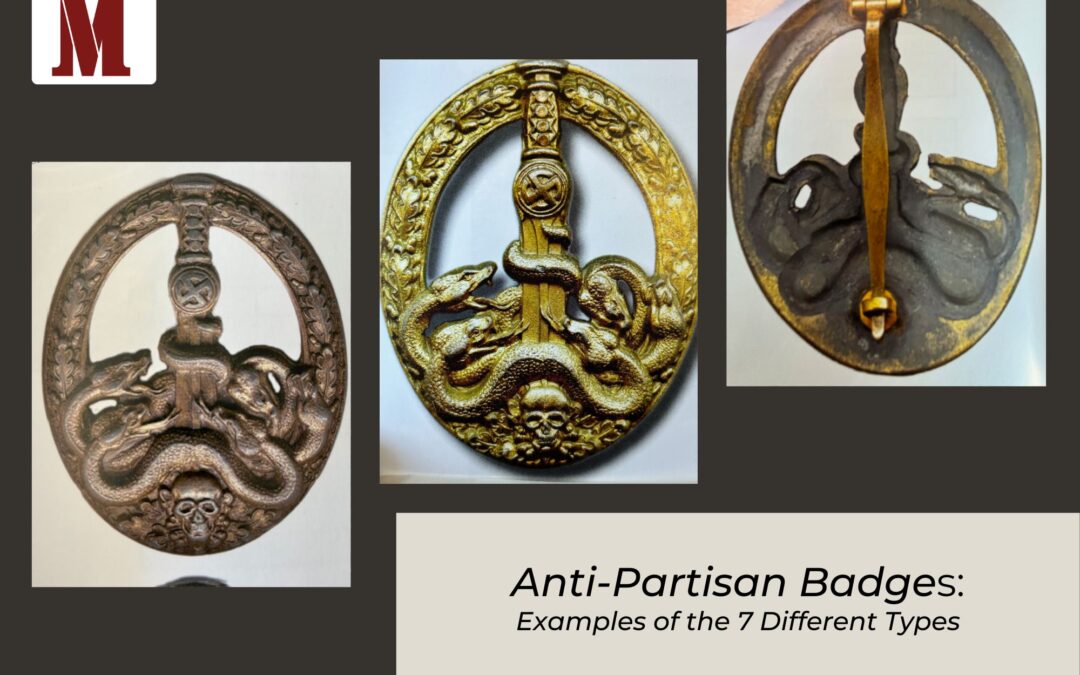Anti-Partisan Badge Creation Process
As we mentioned briefly in the last blog, Anti-Partisan Badge (APB) has many versions depending on the creation process. Today, we’ll dive deeper into the details of the creation process, starting with the stamping methods. The hot stamping method negatively affects the precision and the forming of the metal. With the cold stamping process (the process used on the majority of German WWII badges) there is a better precision of the dimensions and a more precise definition of the features. The hot stamping process is the reason why the APB is a badge with flaws, imprecisions, and variable shapes. After the badge was allowed to cool, it went through the shearing process. Here all the excess material is removed by hand from the badge including the areas between the sword and the oakleaves. If the badge is not perfectly positioned under the cutter blade the sword is twisted either to the left or right making each badge slightly different.
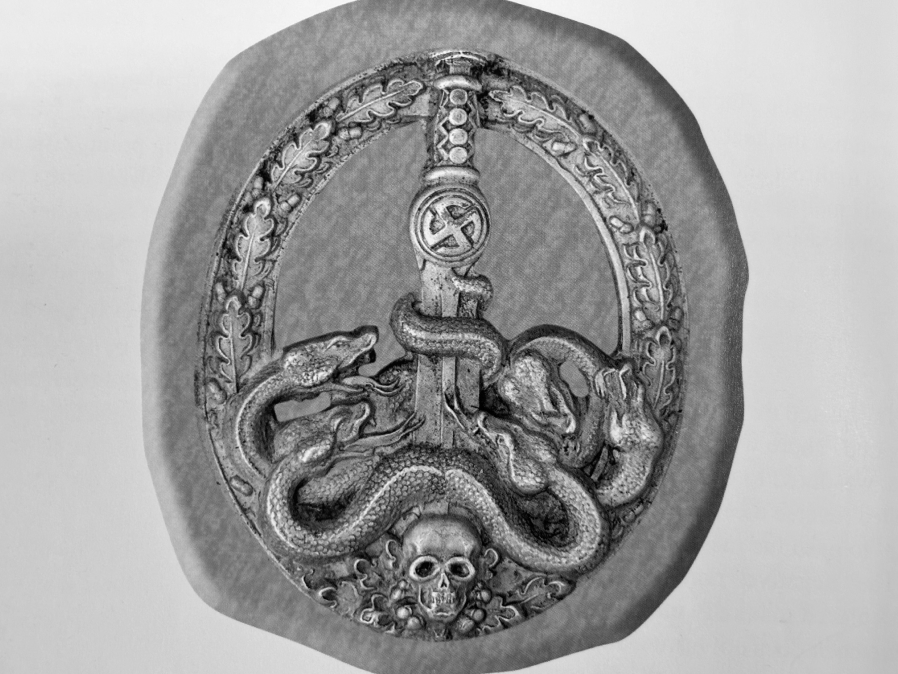
Image: This is a recreation of a finished APB planchet before the excess material is removed.
The next process is punching. Here the worker removes some parts of the areas around the snakes with a chisel. The area is punched from the rear using a single, precise blow. The force needed can cause cuts and cracks at the back of the badge.
The final stage is grinding and filing to remove the burrs and other surplus material left over after the shearing and punching steps. The key to understanding the APB is that the construction process causes many minor differences between similar badges. One can question the wisdom of the Juncker Company using the hot stamping method in making these badges. They were trying to overcome the problems of making badges out of inferior materials and ended up creating a great deal of additional hand work to make a poor-quality badge. The intent of this book is to provide the collector the ability to determine if a badge is original and then be able to classify it as one of the four types of Juncker-made badges.
- Type 1 Needle pin, long barrel hinge, flat wire catch, manually finished
- Type 2.1 Needle pin, long barrel hinge, flat wire catch, chiseled cutouts
- Type 2.2 Needle pin, long & short barrel hinge, flat and round wire catch, two chiseled cutouts
- Type 2.3 Banjo pin, short barrel hinge, flat wire catch, two chiseled cutouts
- Type 3.1 Banjo pin, short barrel hinge, flat wire catch, can be either thick or thin, flattened snake head on the #5 snake
- Type 3.2 Banjo pin, short barrel hinge, flat wire catch, can be either thick or thin
- Type 4 Banjo pin, short barrel hinge, flat wire catch, no cutouts. all examples are thick.
Anti-Partisan Badge Type Examples
Juncker Type 1 Anti-Partisan Badge in Gold
Here is a beautiful example of a Juncker Type 1 APB in Gold. This was the sample for the production run and was manually finished using a small milling machine. It is believed that only a few numbers were made. It is the only type that does not have a slanted sword.
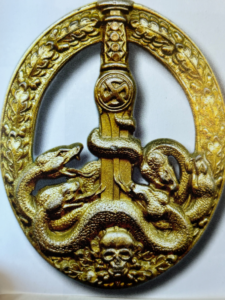
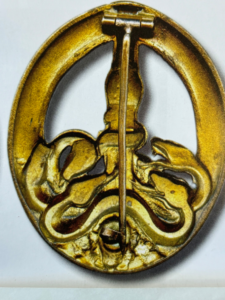
Left Image: The two large open areas on each side of the sword are perfectly milled out as are the cut-outs around the snakes. Right Image: Notice the needle pin, long barrel hinge, and flat wire catch.
Juncker Type 2.1 Anti-Partisan Badge in Silver
The Type 2 consists of three slightly different models. A nice example of a 2.1 Silver badge. All APBs are made from fine zinc. Many times the zinc will absorb the painted finish of the badge.
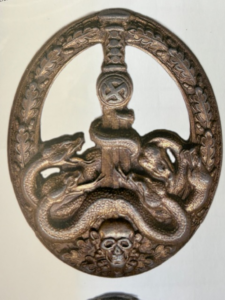
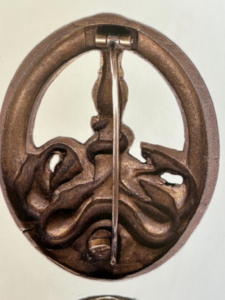
Left Image: The two large open areas are punched out causing the hilt of the sword to be twisted. Right Image:
Juncker Type 2.2 Anti-Partisan Badge
This silver 2.2 is a handsome badge. Notice it has a crack on the edge made by the punching of the areas around the snakes.
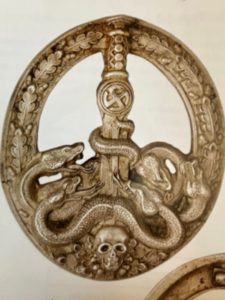
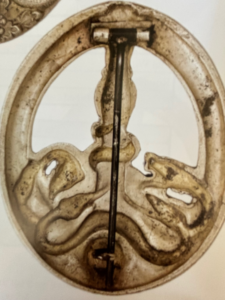
Left Image: Right Image: The back has a needle pin, and can have either long and short barrel hinges, flat and round wire catches, and two chiseled cutouts.
Juncker Type 2.3 Anti-Partisan Badge
Type 2.3 in gold with two cut-outs. It is difficult for me to tell the differences between the three models. It becomes more difficult in the next series.
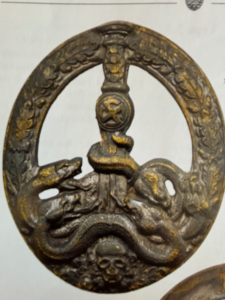

Left Image: A slightly different twist to the sword hilt on all three models. Right Image: Hardware setup system with short barrel hinge, banjo style pin and flat wire catch.
Juncker Type 3.1 Anti-Partisan Badge
The type 3 badge can be either thick or thin and was produced by the same dies as the earlier badges.
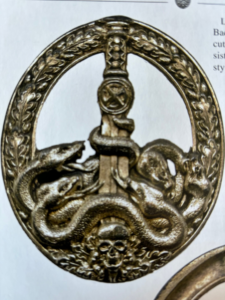
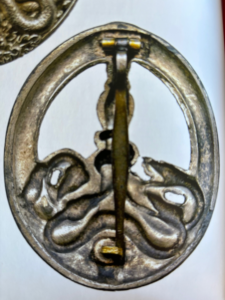
Left Image: The skull is thinner than that of the earlier badges and type 3 almost always has two cutouts. Right Image: Hardware setup with a short barrel hinge, banjo-style pin, and flat wire catch.
Juncker Type 3.2 Anti-Partisan Badge
The APB type 3.2 badge in bronze.
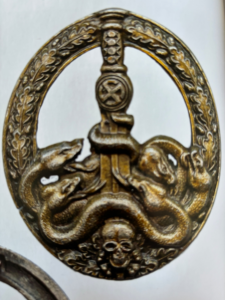
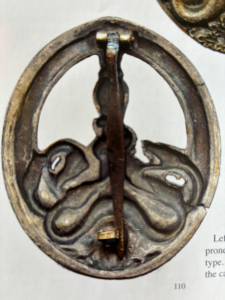
Left Image: The sword is tilted further to the right on this badge. This model has two cut-outs around the snakes and is the last model with this feature. Right Image: The hardware setup is the same as the previous 3.1 badge, This is a thin type 3.2 badge. This badge is more prone to breakage than the thick models.
Juncker Type 4 Anti-Partisan Badge
The final type 4 semi-hollow badge was made by the C.E. Juncker Company. The company produced badges throughout 1944 until their Berlin factory was destroyed in a February 15th air raid. The Juncker semi-hollow badges are the only proven wartime-constructed APBs. The later Steinhauer & Luck and Rudolf Souval flat-back model Anti-Partisan badges are still unconfirmed as originals.
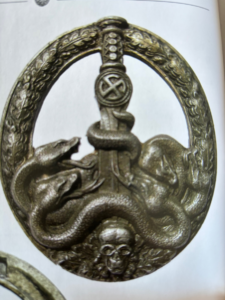
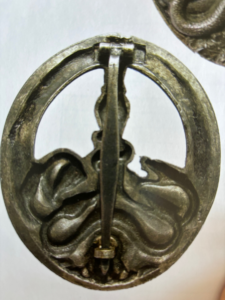
Left Image: The type 4 skull is slightly different, This badge does not have the cut-outs of the earlier badges. Right Image: The hardware setup remains constant with the type 3 badges. All type 4 badges are the thick type.
